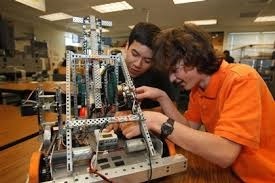College and career readiness means students exit high school prepared for success in a wide range of high-quality post-secondary opportunities. Specifically, college and career readiness refers to the knowledge, skills and dispositions students need in order be prepared for their roles as successful, productive adults in the 21st Century.
California State PTA believes all students should exit high school with a full understanding of the educational and career opportunities available to them, the education necessary to be successful in their chosen pathway and a plan to attain their goals. College and career readiness are neither completely separate, nor identical. Many school districts have created the expectation that their students graduate should be prepared for both and have adapted their instructional programs accordingly.
CAREER TECH EDUCATION
Career Technical Education is a program of study that involves a multiyear sequence of courses that integrates core academic knowledge with technical and occupational knowledge to provide students with a pathway to postsecondary education and careers.
- Linked Learning Pathways – California State PTA has long supported career education and Linked Learning programs in the belief that these programs increase student engagement leading to higher levels of student success and reduced dropout rates. In the Linked Learning approach, students follow industry-themed pathways in a wide range of fields such as engineering, arts and media, biomedicine and health. The term “pathway” is a common term in education and in the Linked Learning context is defined as a multiyear, comprehensive high school program of integrated academic and career technical study that is organized around a broad theme, interest area, or industry sector. An effective linked learning program contains all of the following essential components:
- A challenging academic component that prepares students for success in higher education as well as in apprenticeships and other postsecondary programs.
- A technical component that delivers concrete knowledge and skills through technical courses while emphasizing the practical application of academic learning and preparing students for high-skill, high wage employment.
- A work-based learning component that offers opportunities to learn through real-world experiences. Students gain access to internships, virtual apprenticeships, and school-based enterprises.
Support services that include counseling and supplemental instruction in reading, writing and mathematics to help students master the advanced academic and technical content necessary for success in college and career.
COLLEGE READINESS

College readiness involves being prepared to enroll in and successfully complete entry-level, credit-bearing, academic programs at two- or four-year post-secondary schools. This entails having mastered rigorous content knowledge, demonstrated ability to apply knowledge through higher-order skills, and the ability to navigate the pathways that will provide them access to post-secondary opportunities.
- Graduation Requirements — Minimum requirements for high-school graduation are set by the California Legislature and can be found in California’s Education Code. But students need to know the graduation requirements adopted by their local school districts, which are almost always more extensive. With this information, students can better plan to enroll in the courses that they need to graduate.
- College Entrance Requirements and Tests — Many colleges and universities require students to take an entrance exam such as SAT (Scholastic Aptitude Test) or ACT (American College Testing Program) as part of the application process.
- COVID Update: Both the UC and CSU systems have stated they will not consider SAT or ACT test scores when making admissions decisions or awarding scholarships for the high school class of 2022. However, this may mean that other factors such as grades, strength of curriculum, essays and extracurricular activities might hold even greater weight. Consult with your child’s high school academic counselor to discuss exact details and options.
- College A-G Requirements — Colleges also want to know that your child has taken the kinds of classes that will prepare them to do well when they arrive on campus. Which courses count and which don’t might vary from one college to another, so the best way to be sure your child is eligible at any college they might want to apply to is to satisfy the UC and CSU’s required courses. These are known as the A-G requirements.
- History / Social Science (2 years) “A” – Two years of history/social science, including one year of world history, cultures and geography; and one year of US history, or one-half year of US history AND one-half year of American government.
- English (4 years) “B” – Four years of college-preparatory English. If taking ESL-type classes, only the highest year can be counted towards this requirement.
- Math (3 years required; 4 years recommended) “C” – Three years of college preparatory mathematics; the minimum pattern is Algebra I, Geometry, and Algebra II. Math courses taken in the 7th and 8th grades that the student’s high school accepts as equivalent to its own may be used to fulfill a part of this requirement.
- Laboratory Science (2 years required; 3 years recommended) “D” – Two years of laboratory science in at least two of these three subjects: biology, chemistry, and physics.
- Language Other than English (2 years required; 3 years recommended) “E” – Two years of the same language other than English. Courses taken in the 7th and 8th grades may be used to fulfill part of this requirement if the student’s high school accepts them as equivalent to its own courses.
- Visual and Performing Arts (1 year) “F” – A single yearlong visual or performing arts class such as dance, drama, music, or visual art (drawing, painting, etc.).
- College Preparatory Elective (1 year) “G” – One year chosen from additional “A-F” courses beyond those used to satisfy the requirements above, or courses that have been approved elective classes.
California State PTA has additional resources available to families to help with college planning. Additionally, more information can be found online at the National Association of College Admissions Counseling website.
